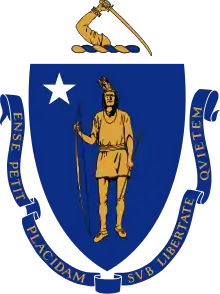Capital punishment in Massachusetts
Capital punishment, more commonly known as the death penalty, was a legal form of punishment from 1620 to 1984 in Massachusetts. This practice dates back to the state's earliest European settlers. Those sentenced to death were hanged. Common crimes punishable by death included religious affiliations and murder.[1]
Federal crimes committed in Massachusetts may still be subject to the death penalty, for example, Dzhokhar Tsarnaev was originally sentenced to death by a federal court on May 15, 2015, for his role in the Boston Marathon bombing.[2]
History
The first recorded execution in Massachusetts was John Billington. He was executed by hanging on September 30, 1630, in Plymouth for murder of John Newcomen.[3]
In the colonial era, Massachusetts' first settlers were Puritans. They came to Massachusetts from England aboard the Mayflower looking for religious freedom. As more people from England came to Massachusetts, they brought new religions and beliefs that conflicted with those of the Puritans. These first settlers created laws prohibiting the practice of other religions that disagreed with Puritan beliefs. Many of these people, specifically Quakers, were hanged for their beliefs. Mary Dyer was one of the Boston Martyrs hanged for being a Quaker.[1] During the Salem witch trials (1692–1693), 19 individuals (14 women and 5 men) were executed for witchcraft by the colonial government.[4]
Between 1788-1951, anyone convicted of first degree murder received the death penalty.[4]
The last executions in Massachusetts were gangsters Philip Bellino and Edward Gertson for the murder of Robert Williams, a former U.S. Marine. Their executions took place on May 9, 1947. The two were executed via electric chair at Charlestown State Prison.[1] Their deaths led to an investigation of the effectiveness of the death penalty in Massachusetts.
History of Abolishment
In 1982, Massachusetts voters approved a legislatively referred constitutional amendment providing that no constitutional provision shall be construed as prohibiting the death penalty, with 60% of voters in favor.[5]
Nevertheless, the state capital punishment statute was struck down in 1984 as a violation of due process, because it allowed a death sentence only when the defendant had pleaded not guilty.[1] The state legislature passed a statute to reinstate capital punishment in 1986 but it was vetoed by then-governor Michael Dukakis. The Massachusetts Catholic Conference was key in gathering the Senate votes necessary to sustain the veto.
Since its abolition in 1984, capital punishment in Massachusetts has continued to stir debate.
In 1997 an attempt by Republican Governor Paul Celluci to reinstate it was defeated by one vote.
Following the homicide of a police officer in Yarmouth in April 2018 and a police sergeant in Weymouth in July 2018, Massachusetts Governor Charlie Baker stated that he supported capital punishment for defendants convicted of murdering a police officer.[6][7]
Further reading
- Alan Rogers. 2008. Murder and the Death Penalty in Massachusetts. Amherst: University of Massachusetts Press.
References
- "Massachusetts". Death Penalty Information Center.
- https://www.nytimes.com/2015/05/16/us/dzhokhar-tsarnaev-death-sentence.html
- Hearn, Daniel Allen. Legal executions in New England : a comprehensive reference, 1623-1960. Jefferson, N.C. ISBN 9780786432486.
- "Massachusetts". Death Penalty Information Center.
- "Massachusetts Death Penalty Constitutional Status, Question 2 (1982)". ballotpedia.org. Retrieved June 20, 2017.
- "In wake of Sean Gannon's killing, Gov. Charlie Baker 'supports the death penalty' for cop killers in Massachusetts". MassLive.com. Advance Publications. April 18, 2018. Retrieved October 28, 2018.
- Croteau, Scott J. (July 18, 2018). "Discussion of death penalty for cop-killers reemerges after shooting of Weymouth Sgt. Michael Chesna". MassLive.com. Advance Publications. Retrieved October 25, 2018.
